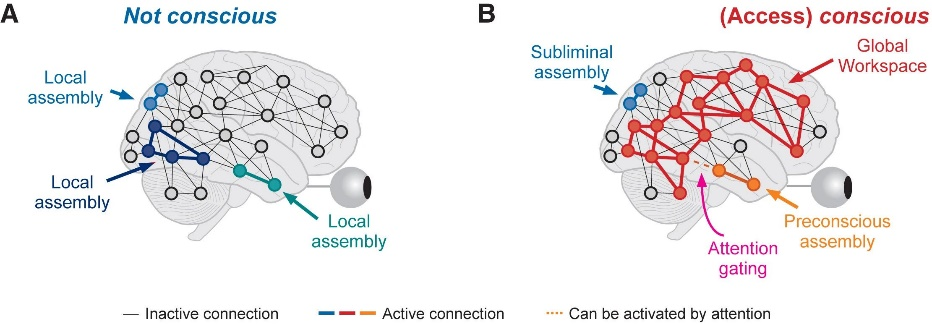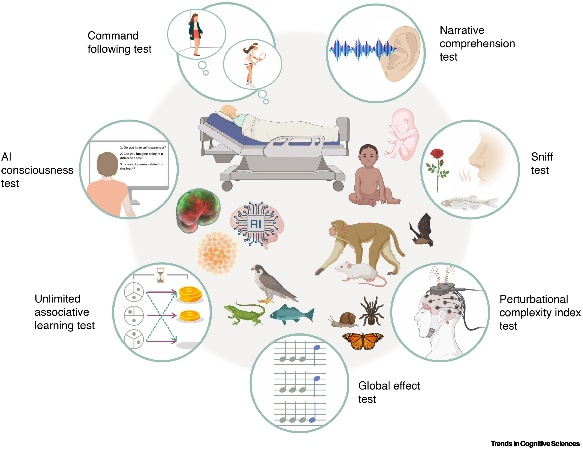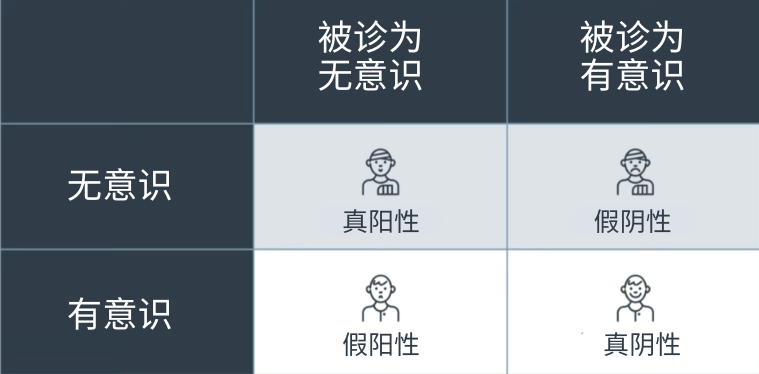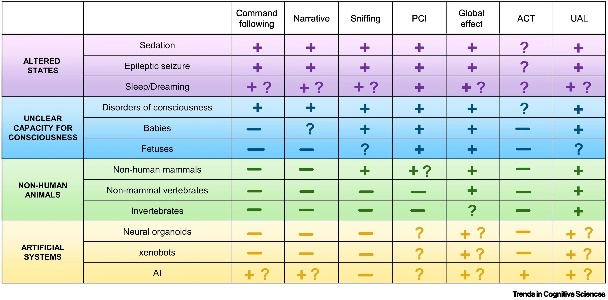Jean-Dominique Bauby, who once served as the editor-in-chief of the French fashion magazine Elle, describes in his book The Diving Bell and the Butterfly the sensation of a patient with locked-in syndrome being imprisoned in an immobile body, based on his own experiences.
Before this, Alexandre Dumas had already depicted a scenario in The Count of Monte Cristo where a fully intact consciousness is buried within an immobile body—Monsieur Noirtier de Villefort cannot speak or move his limbs, but through eye movements, he tries to prevent a murder and an undesirable marriage.
These real or fictional cases reflect a widespread concern about the “distribution of consciousness.”

▷ The Diving Bell and the Butterfly film adaptation
In fact, “consciousness” is a concept that has only flourished in recent times. Although research related to consciousness can be traced back to ancient Greece, and even hints of consciousness and the subconscious can be found in primitive cave paintings, research focusing specifically on consciousness itself has a very short history.
In the early 1980s, the term “consciousness” was still taboo in serious scientific publications. Many researchers believed that defining consciousness was outdated and ambiguous, and that the use of the term “consciousness” added no value to psychology.
It was not until the late 1980s that consciousness research took a turn for the better*. The intuitive ideas about the “distribution of consciousness” in folk psychology have also received increasing attention [1]. We usually think that people in a waking state are conscious, while in states of intoxication, mental illness, anesthesia, coma, vegetative state, and brain death, the degree of consciousness progressively decreases.
For research on the shift in attitudes toward consciousness, refer to Stanislas Dehaene’s Consciousness and the Brain. This observation is partly based on Dehaene’s personal experience and partly on his academic research.
In addition to folk psychology, clinical practice also pays significant attention to the issue of the distribution of consciousness. Clinically, diagnosing whether a patient is brain-dead or in a vegetative state requires measuring the degree of consciousness. Furthermore, from a broader perspective, how do we determine the existence of consciousness? Which animals can be included in the “consciousness club,” and in what ways do they possess consciousness? For example, is the consciousness of an octopus dispersed or unified? Do organelles or artificial intelligence systems, such as large language models with strong communicative abilities, possess consciousness? These studies from different perspectives and levels ultimately point to the investigation of the nature of consciousness—is consciousness unified? Is consciousness multiply realizable (e.g., through physical, computational, or modeling means)?
Currently, there are roughly 22 theories of consciousness, and to adjudicate the distribution of consciousness, we need to base our judgments on a universally accepted theory of consciousness. However, most theories of consciousness are centered on human consciousness, making it very difficult to explain the distribution of consciousness in animals.
To address this, Tim Bayne, Anil Seth, and others have taken a different approach. In the paper “Tests for Consciousness in Humans and Beyond,” they attempt to provide a framework for consciousness tests based on the key characteristics of consciousness testing and offer strategies for proving the validity of these tests. This builds a bridge between consciousness assessments and theoretical frameworks, ultimately leading to a deeper understanding of the nature of consciousness. This testing framework can not only be used to evaluate and revise existing consciousness tests but also guide the construction of new ones.

▷ Bayne, Tim, et al. “Tests for consciousness in humans and beyond.” Trends in Cognitive Sciences (2024).
1. From the Hard Problem to the Real Problem
In Consciousness and the Brain, Stanislas Dehaene identifies three key elements that have revitalized consciousness research: a more precise definition of consciousness; discoveries that allow for the experimental manipulation of consciousness; and the academic community’s renewed emphasis on studying subjective phenomena. These factors have collectively helped consciousness research emerge from its “winter.” The advent of new research tools such as electroencephalography (EEG), functional magnetic resonance imaging (fMRI), and magnetoencephalography (MEG) has accelerated this progress.
The three elements emphasized by Dehaene are directly related to the core features of consciousness research. Among them, “experimentally manipulable consciousness” primarily focuses on the accessibility of consciousness and first-person reports. “Subjective phenomena” refer to the “what it is like” subjective characteristics highlighted by Thomas Nagel in his essay “What Is It Like to Be a Bat?” or what Ned Block describes as phenomenal consciousness.
Additionally, the characteristics pointed out by Dehaene reveal the challenges in consciousness research, specifically the distinction between the “hard problem” and the “easy problem” of consciousness as articulated by David Chalmers. The hard problem concerns how phenomenal consciousness arises from its physical basis and how to account for the reality of phenomenal consciousness in the universe. In contrast, the easy problem addresses how physical systems generate responses with specific functional or behavioral performances. Simply put, the hard problem deals with how a physical brain can possess phenomenality, while the easy problem examines how particular types of conscious experiences are produced.
Although addressing the easy problem is not without difficulty, it is relatively straightforward because there is no conceptual gap between physical systems and their functional or behavioral manifestations. However, even if all easy problems are solved, the hard problem remains unresolved. As George Mather stated, the “hardness” that Chalmers refers to implies that solving this problem seems impossible.
Subsequently, the philosophy of mind and consciousness science have pursued the mysteries of consciousness along different paths. The philosophy of mind has developed a series of theories, such as physicalism and functionalism, in an attempt to provide answers to the hard problem. Consciousness science, on the other hand, avoids direct discussion of phenomenality and approaches the subject through first-person reports and the accessibility of consciousness.
For example, the Global Workspace Theory and Higher-Order Thought Theory focus on the function or behavioral manifestations of consciousness. The former posits that the core of consciousness lies in the accessibility of information within a global workspace, while the latter emphasizes the reference of higher-order representations to first-order representations, reflected in the brain as the prefrontal cortex referencing other brain regions. Even if subjective reports of conscious phenomena largely align with the explanations provided by these theories, this consistency only indicates some form of correlation and does not directly explain the phenomena themselves.

▷ For Global Neural Workspace Theory, see: Is a Grand Unified Theory of Consciousness Coming?
Anil Seth points out that we should neither be confined to debates over the hard problem nor neglect the phenomenality of consciousness. Instead, we should shift our attention to the real problem of consciousness. The real problem of consciousness attempts to integrate phenomenality, measurement, and explanations of consciousness to explain, predict, and control phenomenally characterized experiences. Anil Seth believes that we can anticipate that answers to the real problem will ultimately allow the hard problem to “fade into the metaphysical fog.” This shift in perspective provides us with a new path for studying consciousness. The transition from the hard problem to the real problem places consciousness testing and theoretical frameworks in a more central role, with the two mutually clarifying and corroborating each other, thereby contributing to a deeper understanding of consciousness.
2. Measurement of Consciousness
When discussing consciousness, we often consider related concepts such as wakefulness, attention, intelligence, voluntary behavior, and self-regulation. Generally speaking, individuals in a state of wakefulness are deemed conscious. Vegetative patients, while still experiencing day-night cycles, do not clearly possess consciousness. The emergence of conscious mental states requires the operation of attention. However, even sub-threshold operations of attention contribute to the manifestation of mental states. Therefore, attention is not synonymous with consciousness. Bayne et al. point out that consciousness tests should not focus solely on the abilities associated with consciousness mentioned above but should instead target phenomenal consciousness directly. Abilities that covary with consciousness, such as attention and perceptual organization, are at best tools for guiding the search.
The scope of consciousness research cannot be too broad or too narrow. Humans, capuchin monkeys, mice, and octopuses exhibit different manifestations of consciousness; these different manifestations are neither modeled on human consciousness nor derived from it. In fact, human consciousness represents just a small part of the broader landscape of consciousness. Therefore, defining the boundaries of consciousness research must consider these diverse manifestations, which in turn require distinct tests.

▷ Examples of Consciousness Tests.
3. Standard Consciousness Tests
The term “consciousness” typically refers to a state of consciousness, but this does not presuppose the existence of a universally applicable and definitive consciousness test. Methods for assessing consciousness are diverse, each with its own focus. Some consciousness tests concentrate on the general features of consciousness without conveying information about its content, such as the Perturbational Complexity Index (PCI) test. These types of tests focus on neural integration and differentiation rather than on individual behavioral responses or reactions to mental imagery.
Another category of consciousness tests focuses on specific conscious contents or mental abilities sufficient to trigger consciousness. These include bodily sensations (such as pain and smell), autonomous responses (generating and maintaining mental imagery), the ability to discriminate between sub-threshold and supra-threshold stimuli, and various types of learning abilities. The interpretation of these tests depends on whether the selected mental abilities are strong indicators of consciousness.
Faced with such diversity, how can we determine whether a particular consciousness test is applicable to a specific group? Why can the results of a consciousness test be regarded as reliable evidence of the presence or absence of consciousness? Additionally, how should we understand the relationships between different types of consciousness tests? To address these questions, Bayne et al. propose a “four-dimensional space of consciousness tests,” aiming to provide a more systematic framework for understanding consciousness tests.
4. The Four-Dimensional Space of Consciousness Tests
The first dimension of the four-dimensional space emphasizes the limited applicability of consciousness tests. In other words, different consciousness tests should be designed for target groups exhibiting varying manifestations of consciousness. Some consciousness tests may be suitable only for humans and other primates; others might apply to a broader range of mammals, and still, others could be utilized for more diverse entities, including evolving biological systems and artificial intelligence. Ideally, a universally applicable consciousness test would encompass all types, but this is unlikely to be achievable in the short term.
Furthermore, the goal of consciousness tests is to accurately determine whether an individual possesses consciousness. This means that the tests should neither incorrectly classify unconscious individuals as conscious (false positives) nor mistakenly identify conscious individuals as unconscious (false negatives). The former is referred to as the specificity of the consciousness test, measured by a low false positive rate; the latter is known as sensitivity, measured by a low false negative rate. These two concepts—specificity and sensitivity—constitute the remaining two dimensions of our discussed four-dimensional space.

▷ Example: Sensitivity refers to the proportion of truly unconscious individuals who are correctly diagnosed as unconscious. Specificity refers to the proportion of truly conscious individuals who are correctly diagnosed as conscious. More specifically, false positives refer to individuals who have been incorrectly diagnosed as unconscious; False negative refers to a person who is mistakenly diagnosed as conscious.
Take, for example, the command-following test for human consciousness. This test is commonly used with patients who exhibit no observable behavioral responses. By monitoring neural activity in response to mental commands, we can assess whether they possess consciousness. In many clinical cases, this test is considered a reliable indicator of the presence of consciousness and is also a crucial tool for determining minimal consciousness states.
However, there are exceptions to this test. Some epilepsy patients may pass the command-following test, but their responses might merely be unconscious habitual actions, such as automatic walking, which do not conclusively demonstrate consciousness. Additionally, conscious patients might fail the test if they do not hear or understand the commands.
This implies that even consciousness tests are not always entirely accurate. The specificity (the ability to correctly exclude unconsciousness) and sensitivity (the ability to correctly identify consciousness) of a test do not always align. A test with high specificity but low sensitivity might miss genuinely conscious patients, while a test with high sensitivity but low specificity might incorrectly classify unconscious patients as conscious.
Specificity and sensitivity are based on the limited applicability of consciousness tests and depend on the specific target group. We cannot expect high specificity for a particular group to transfer to another type of target group. Low-specificity consciousness tests are not entirely useless; they may indicate that current research on the distribution of consciousness within specific groups is misguided.
As previously mentioned, the false positive rate and false negative rate are important indicators of specificity and sensitivity, respectively. However, these are statistical terms that can only provide inductive explanations. Therefore, the final dimension of consciousness tests is rational confidence. This is a second-order criterion that assesses whether the specificity and sensitivity are reasonable, attempting to link scientific tests with intuitive judgments about consciousness in folk psychology*. Tests with high rational confidence better align with our everyday understanding of consciousness, whereas tests with low rational confidence may yield results that starkly contrast with our intuitions, making their outcomes more suggestive than definitive. Establishing this dimension essentially measures the overall efficacy of a consciousness test.
Achieving high rational confidence is challenging in the short term, especially for consciousness tests designed to assess the consciousness levels of other animals, given our limited folk psychological judgments about the distribution of consciousness in non-human species.

▷ Scope of Consciousness Tests: The applicability of different consciousness tests (rows) to various target groups (columns). A plus sign (+) indicates that the test may meaningfully apply to a specific population (although its specificity/sensitivity might be low) and may require some modifications. A dash (−) signifies that the test is not applicable or irrelevant to a particular population. A question mark (?) suggests that the test might be applicable but requires further development to determine its suitability. Lastly, a combination of a plus sign and a question mark (+?) indicates that while the test can be applied, it is unclear what the results signify.
5. How to Prove the Validity of Consciousness Tests
How can we demonstrate the validity of a consciousness test and assess its rational confidence? How can we determine the specificity and sensitivity of consciousness tests? First and foremost, we cannot simply conclude that a consciousness test is valid by proving that a particular group possesses consciousness. Instead, we must first establish that the consciousness test is usable and that its results are reliable before we can determine the degree of consciousness present in the target group. Therefore, demonstrating the validity of consciousness tests is crucial.
In this context, Seth, Bayne, and others outline three strategies for proving the validity of consciousness tests in their article. These strategies are not mutually exclusive; they merely focus on different core factors. The redeployment strategy assumes the validity of certain consciousness tests and uses this assumption as a foundation to discuss the validity of other related tests. However, the validity of the foundational tests themselves remains to be demonstrated. The theory-based strategy offers a more robust foundation compared to the redeployment strategy. However, since the field of consciousness theories has not yet reached a definitive conclusion and different consciousness theories support different consciousness tests, there is no unified answer as to which theory should serve as the basis for consciousness tests. Compared to the first two, the iterative natural kind strategy may be a better choice. This strategy views consciousness as a natural kind, providing a basis for further reasoning and generalization. Its iterative nature creates a positive feedback loop between consciousness tests and consciousness theories.
Strategy One: The Redeployment Strategy
The redeployment strategy posits that there are already some consciousness tests with broad validity, and other tests to be considered are variants of these existing tests. Therefore, we can extend the validity of existing tests to their variants. In everyday life, we generally acknowledge that overt behavior signifies consciousness, and covert maintenance of mental imagery is a variant of overt behavior. The command-following test uses this as an indicator to provide evidence for the presence or absence of consciousness.
This is a relatively conservative strategy, merely extending existing valid consciousness tests. However, it also involves a risky leap. Firstly, this strategy is entirely empirical, seemingly assuming that existing consciousness tests have sufficiently validated their effectiveness. However, their validity is only empirically grounded and does not constitute rational justification. Secondly, the extension has boundaries; this strategy only allows for the extension of the original test’s content variants and, in principle, cannot be applied to other target groups. Thus, it ultimately only tests the same target group’s consciousness state in different ways. For example, using a variant of the command-following test to measure the consciousness state of human patients does not allow this test to be applied to artificial intelligence systems.
For the redeployment strategy to achieve a robust foundation, it requires proving the validity of the foundational tests through other means or accepting the deflationism of consciousness, which holds that any system that can reliably follow commands is conscious. However, we cannot prove the validity of consciousness independently of consciousness tests, nor do we have a prior definition of consciousness. Both paths are unfeasible.

▷ Katya Dorokhina
Strategy Two: The Theory-Based Strategy
The redeployment strategy either seeks another foundation or embraces some form of deflationism of consciousness. In any case, this strategy faces fundamental challenges. Since the redeployment strategy lacks a theoretical foundation, some have proposed invoking consciousness theories to demonstrate the validity of consciousness tests. The basic premise of this strategy is that consciousness tests that fit well with well-grounded and validated consciousness theories can serve as reliable indicators of consciousness. For example, the Global Workspace Theory supports the Global Effect Test, and the Information Integration Theory inspires the Perturbational Complexity Index (PCI) test.
The theory-based strategy also encounters several challenges. As previously mentioned, no single consciousness theory has gained widespread acceptance; at least 22 consciousness theories are being seriously considered, some of which have variants, and these theories support different consciousness tests*. If these diverse theories could eventually be integrated, the existing disagreements would no longer pose a challenge. However, this is not the case, as different consciousness theories have not shown a trend towards convergence.
There are instances where different theories support the same consciousness test. Farisco and Changeux, in their 2023 article, discuss the fundamental compatibility between the Perturbational Complexity Index test and the Global Neural Workspace Theory. Nonetheless, overall, different consciousness theories support different consciousness tests.
Based on this, Chalmers and others suggest that an integrated framework for consciousness theories might resolve this issue, with different consciousness theories holding varying weights within this framework and multiple consciousness tests being combined accordingly. This idea may be feasible, but in practice, reaching a consensus on the weights of consciousness theories is challenging, much like the unresolved disputes within consciousness theories themselves.
This strategy may also face the challenge of anthropocentrism. Many consciousness theories are built with humans as the reference point, raising questions about how these theories apply to other groups. For instance, the Global Workspace Theory explains the mechanism of human consciousness but does not specify which systems possess a global workspace. There is evidence that fish have structures similar to a global workspace, and the lateral neurons in birds’ tails might perform functions analogous to the human prefrontal cortex, but how to determine their similarity remains unclear. Beyond these animals, how should other animals be treated?
The third challenge involves the bidirectional dependency between consciousness science and consciousness philosophy. To validate a consciousness theory, one needs to rely on consciousness tests; simultaneously, consciousness tests require a specific consciousness theory for support. This situation creates a cycle where a theory depends on tests for validation while also being used to validate the tests, forming an intractable loop.
Strategy Three: The Iterative Natural Kind Strategy
To break free from the non-virtuous cycle between consciousness tests and consciousness theories, Bayne and others propose the iterative natural kind strategy. This strategy views consciousness as a natural kind, where natural kinds are categorized based on essential commonalities (rather than superficial similarities, arbitrary feature combinations, or purely human interests), allowing for the division of the world “at its joints” in a way that reflects the structure of the natural world.

▷ Illustration of the Iterative Natural Kind Strategy
If consciousness is a natural kind, this offers several advantages for research. Firstly, different manifestations of consciousness belonging to the same natural kind share the same essence, which can be discovered through iterative steps, much like scientists have uncovered the essence of heat. The process of revealing the essence of heat began with some pre-theoretical assumptions, which were continually refined through the theory’s unity, simplicity, and explanatory power.
The process of uncovering the essence of consciousness could also result from the iteration between experiments and theories, not only aiding in the construction of more accurate consciousness tests but also helping us better understand the distribution of consciousness. Iteration simultaneously involves retaining and transcending; consciousness theories retain some ideas from folk psychology but are not derived from the initial pre-theoretical assumptions. Instead, they transcend and refine these assumptions. The resulting consciousness theories do not contradict folk psychology but are more rigorous, systematic, and grounded in ongoing empirical evidence.
The natural kind strategy can also effectively address the generalization problem. Since consciousness is a natural kind with a shared essence, starting from the characteristics of some groups, we can first extend to proximate groups with similar features and then to other groups with different features. Theoretically, this is feasible, though during the extension process, the confidence in pre-theoretical assumptions diminishes. Therefore, the validity provided by the natural kind strategy is hierarchical.
However, it remains undecided which features to use for expansion and which groups are closest to human consciousness. Different measurement standards can yield different proximities, whether behavioral, functional, or neurophysiological. For example, individuals with a nervous system exhibit varying degrees of response in states of complete motor inhibition, a phenomenon particularly evident in human clinical conditions, human infants, and some animals. In contrast, artificial intelligence systems and cellular structures differ significantly from humans in this regard. Therefore, the better we understand the underlying mechanisms of human consciousness, the more accurately we can stratify different groups.
Since the consciousness of different groups is interrelated, the validity of any consciousness test must rely on other forms of verification. Simultaneously, developing independent and effective consciousness tests is crucial, enabling consciousness tests to not only corroborate each other but also correct one another.
The iterative natural kind strategy presents a virtuous cycle between consciousness tests and consciousness theories, offering a hierarchical and expandable structure for understanding consciousness. This provides a reliable path for deepening our comprehension of consciousness.
6. Conclusion
This paper delineates a four-dimensional space for developing robust and generalizable consciousness tests by capturing the key characteristics of consciousness testing. This framework not only enables us to evaluate the strengths and weaknesses of individual tests and better comprehend how they interrelate but also provides a solid foundation for developing more refined assessments. An ideal consciousness test possesses universal applicability, perfect specificity and sensitivity, and high rational confidence, thereby establishing it as an effective measure of consciousness.
Furthermore, the paper introduces three strategies for validating the effectiveness of these tests: the redeployment strategy, the theory-based strategy, and the iterative natural kind strategy. Among these, the iterative natural kind strategy is considered the ideal choice. This strategy posits that consciousness is a natural kind, and we should begin with tests for groups closely related to us and then systematically and purposefully expand to other groups.
The four-dimensional space and the validation strategies serve as a bridge between consciousness tests and consciousness theories, as well as a nexus connecting third-person experimental results with the subjective characteristics of conscious experience. All of this ultimately aids in addressing critical questions in the fields of consciousness science and philosophy of mind: What is consciousness? Is a unified theory of consciousness possible? How should we understand the relationship between consciousness and folk psychology?
[1] 斯坦尼斯拉斯·迪昂,《脑与意识》,浙江教育出版社,2018年10月。
[2] Anil Seth, Being You:A New Science of Conscousness, Faber & Faber, 2021.
[3] Bayne, Tim ; Seth, Anil K. ; Massimini, Marcello ; Shepherd, Joshua ; Cleeremans, Axel ; Fleming, Stephen M. ; Malach, Rafael ; Mattingley, Jason ; Menon, David K. ; Owen, Adrian M. ; Peters, Megan A. K. ; Razi, Adeel & Mudrik, Liad (2024). Tests for consciousness in humans and beyond. Trends in Cognitive Sciences 29.